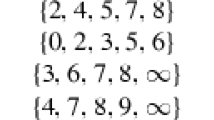Abstract
Combinatorial designs have long been used to design efficient statistical experiments. More recently, connections to the theory of cryptographic communications have emerged. Combinatorial designs have provided solutions to problems coming from signal processing, radar, error-correcting codes, optical orthogonal codes, and image processing. Further, the most elegant solutions have come from designs with prescribed automorphisms. In this paper, we focus on partial geometric designs, a generalization of the classical 2-design. These designs have recently been shown to produce two directed strongly regular graphs. We generalize the well-known Kramer–Mesner Theorem for 2-designs to partial geometric designs. We also construct infinite families of partial geometric designs admitting a group of automorphisms which acts regularly on the point set and semi-regularly on the block set. The designs are obtained from new constructions of partial geometric difference families. These families were recently introduced a generalization of both the classical difference family and the partial geometric difference set.
Similar content being viewed by others
Notes
A directed strongly regular graph with parameters \((\mathbf{{v, k, t}},\lambda , \mu )\) is, by definition, a directed graph on \(\mathbf{{v}}\) vertices without loops such that (i) every vertex has in-degree and out-degree \(\mathbf{{k}}\), (ii) every vertex x has \(\mathbf{t}\) out-neighbors that are also in-neighbors of x, and (iii) the number of directed paths of length 2 from a vertex x to another vertex y is \(\lambda \) if there is an edge from x to y, and is \(\mu \) if there is no edge from x to y [9].
References
Arasu K.T.: Sequences and arrays with desirable correlation properties. Inf. Secur. Coding Theory Relat. Comb. 29, 136–171 (2011).
Bose R.C., Bridges W.G., Shrikhande M.S.: A characterization of partial geometric designs. Discret. Math. 16(1), 1–7 (1976).
Bose R.C., Shrikhande S.S., Singhi N.M.: Edge regular multigraphs and partial geometric designs with an application to the embedding of quasi-residual designs. Colloq. Int. Sulle Teorie Comb. 1, 49–81 (1976).
Brouwer A.E., Olmez O., Song S.Y.: Directed strongly regular graphs from \(1\frac{1}{2}\)-designs. Eur. J. Comb. 33(6), 1174–1177 (2012).
Buratti M.: Recursive constructions for difference matrices and relative difference families. J. Comb. Des. 6, 165–182 (1998).
Buratti M., Wei Y., Wu D., Fan P., Cheng M.: Relative difference families with variable block sizes and their related OOCs. IEEE Trans. Inf. Theory 57, 7489–7497 (2011).
Chung F.R.K., Salehi J.A., Wei V.K.: Optical orthogonal codes: design, analysis, and applications. IEEE Trans. Inf. Theory 35, 595–604 (1989).
Cusick T.W., Ding C., Renvall A.: Stream Ciphers and Number Theory. North-Holland Mathematical Library, vol. 55. North-Holland/Elsevier, Amsterdam (1998).
Duval A.: A directed graph version of strongly regular graphs. J. Comb. Theory (A) 47, 71–100 (1988).
Golomb S.W.: Digital Communication with Space Application. Penisula, Los Altos (1982).
Helleseth T., Kumar P.V.: Sequences with low correlation. In: Pless V., Huffman W.C. (eds.) Handbook of Coding Theory. Elsevier, Amsterdam (1998).
Jungnickel D., Pott A.: Perfect and almost perfect sequences. Discret. Appl. Math. 95, 331–359 (1999).
Kim J.H., Song H.Y.: Existence of cyclic Hadamard difference sets and its relation to binary sequences with ideal autocorrelation. J. Commun. Netw. 1, 14–18 (1999).
Kramer E.S., Mesner D.M.: \(t\)-Designs on hypergraphs. Discret. Math. 15, 263–296 (1976).
Kreher D.L., Radziszowski S.P.: The existence of simple \(6-(14, 7, 4)\) designs. J. Comb. Theory Ser. A 43, 237–243 (1986).
Massey J.L., Mathys P.: The collision channel without feedback. IEEE Trans. Inf. Theory 31, 192–204 (1985).
Neumaier A.: \(t\frac{1}{2}\)-designs. J. Comb. Theory A, 28(3), 226–248 (1980).
Nowak K., Olmez O., Song S.Y.: Partial geometric difference families. J. Comb. Des. (to appear).
Olmez O.: Symmetric 112-designs and 112-difference sets. J. Comb. Des. 22(6), 252–269 (2014). doi:10.1002/jcd.21354.
Salehi J.A.: Emerging optical code-division multiple-access communications systems. IEEE Netw. 3, 31–39 (1989).
Salehi J.A., Vecchi M.P.: Neuromorphic networks based on sparse optical orthogonal codes. Neural information processing systems-natural and synthetic. Am. Inst. Phys. 814–823 (1988).
Sloane N.J.A., Thompson J.G.: The nonexistence of a certain Steiner system \(S(3, 12, 112)\). J. Comb. Theory Ser. A 30, 209–236 (1981).
Stinson D.R.: Combinatorial Designs: Constructions and Analysis. Springer, New York (2004).
van Dam E.R., Spence E.: Combinatorial designs with two singular values II. Partial geometric designs. Linear Algebr. Appl. 396, 303–316 (2005).
Xiang Q.: Recent progress in algebraic design theory. Finite Field Their Appl. 11, 622–653 (2005).
Zhao H.: On balanced optimal (18u, 3,4, 1) optical orthogonal codes. J. Comb. Des. 20, 290–303 (2012).
Author information
Authors and Affiliations
Corresponding author
Additional information
Communicated by K. T. Arasu.
Rights and permissions
About this article
Cite this article
Nowak, K., Olmez, O. Partial geometric designs with prescribed automorphisms. Des. Codes Cryptogr. 80, 435–451 (2016). https://doi.org/10.1007/s10623-015-0111-5
Received:
Revised:
Accepted:
Published:
Issue Date:
DOI: https://doi.org/10.1007/s10623-015-0111-5



